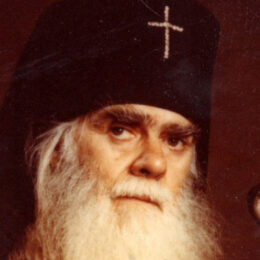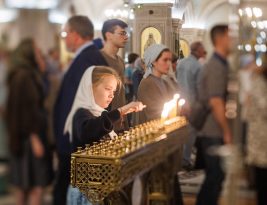The rites were quiet, yet elaborate, and drew small clusters of dedicated worshippers out of their homes on a Saturday morning and into Byzantine sanctuaries across the nation.
Somewhere in each church stood an icon of a dignified Arab wearing the rich liturgical vestments of an Eastern Orthodox bishop. The worshippers took turns kissing the icon and chanters gave thanks to God for the work of the new saint whose name still causes smiles — St. Raphael of Brooklyn.
“It isn’t every day that you hear the word ‘Brooklyn’ used in a Divine Liturgy,” said Father Gregory Mathewes-Green, the priest in my own parish near Baltimore. “St. Raphael is important not only because he lived a remarkable life, but because of where he came from and who he was. He is a wonderful symbol for Orthodox unity in America. Š
“Our church was unified in his day and we pray it can be unified again.”
Father Raphael Hawaweeny came to the United States in 1895 and became the first Eastern Orthodox bishop consecrated in this land. He was known as the “Good Shepherd of the Lost Sheep in America.”
St. Raphael was canonized in 2000 by the Orthodox Church in America (OCA), which has Russian roots, in cooperation with the Antiochian Orthodox Christian Archdiocese of North America, with its ancient ties to the Middle East. The OCA celebrates St. Raphael’s feast day on Feb. 27, the date of his death.
This monk, priest, diplomat, scholar, missionary and bishop traveled a risky and complicated road on the way to Brooklyn, a fact noted by chanters during the rites last weekend. One of the prayers said: “Arab by birth, Greek by education, American by residence, Russian at heart and Slav in soul, thou didst minister to all, teaching the Orthodox in the New World to proclaim with one voice: Alleluia.”
In other words, each Orthodox flock can lay some claim to this particular saint. There are about 5 million Eastern Orthodox Christians in the United States and 250 million worldwide. While the church has grown in America, primarily through converts from evangelical and mainline Protestant pews, the Orthodox map here remains a crazy quilt of overlapping ethnic jurisdictions.
But there are signs of unity in combined programs for foreign missions, relief efforts and education. And last month, Father Thomas Hopko, one of America’s most respected Orthodox scholars, dared to produce a rough-draft of a plan for unity. While Hopko is an OCA priest, his essay was published by the Antiochian archdiocese.
Both of these churches now worship in English and include large numbers of converts at their altars and in their sanctuaries. Their most vital parishes are becoming more and more alike, he noted.
“The seven Antiochian bishops include three born in America, one of whom is a convert to Orthodoxy,” wrote Hopko, dean emeritus of St. Vladimir’s Orthodox Theological Seminary in Crestwood, N.Y. The OCA offers “nine bishops born in the USA, one born in Canada, one in Mexico, one in Bulgaria and one in Romania. Eight of the 13 OCA bishops are converts to Orthodoxy. Š
“What an impressive synod these bishops could form to govern a unified Orthodox Church in North America!”
Any attempt to accomplish this would lead to an outbreak of Byzantine politics, especially in Greece, Turkey and Syria. Hopko admitted that it would take years to handle issues of assets, property, diocesan borders and lines of authority.
What would the Greeks do? Who would make the first move? How would a united synod select a patriarch? On this question, Hopko suggested that each church select one candidate and the primate would be “chosen by lot,” with a senior priest picking “his name from a chalice after an All-night Vigil, Divine Liturgy and Service of Prayer.”
The key is to regain the vision briefly seen in the work of the first Orthodox missionaries to North America — like St. Raphael.
“All Orthodox churches in the United States, Canada and Mexico would be invited to join in the common work of the new church,” wrote Hopko. “No Orthodox would be excluded. All Orthodox would be welcome.
This could take place by 2008, according to Hopko.
It would take sacrifice and cooperation and a shepherd who can command the trust of the Arabs, Greeks, Russians, Slavs and the Americans.
Terry Mattingly (www.tmatt.net) is senior fellow for journalism at the Council for Christian Colleges & Universities. He writes this weekly column for the Scripps Howard News Service.




St.Raphael suffered for the sake of the his flock and to help St. Tikhon create a united Orthodox Church in America. The Patriarchate of Damascus shunned him for his work. If we want a united Orthodox Church we have to be prepared for some pain. Working for Orthodox unity will mean carrying the cross.
St. Raphael sent my home parish our first priest and we had an icon of him, without the halo, before he was an official saint. I am in favor of legitimate Orthodox jurisdictional unity. That being said, I have some serious concerns about the tenor of this proposal. If it were just a unification of we Antiochians and the OCA–three cheers, AXIOS. However, the wider sweep of the proposal may very well create a hardening of jurisdicitonal walls in order to protect turf. The samll, largely slavic jurisdictions will be pressured to join to try to achieve parity with the Greeks in terms of numbers. They will probably not like the squeeze play. In fact, by brother is a priest in one such jurisdiction and is already troubled by it.
IMO, the Greek archdiocese won’t do it for several reasons one real big one is the lack of favor such an idea would likely have with Patriarch Bartholomew.
St. Raphael achieved his sainthood by his unstinting service to all Orthodox regardless of jurisdiction or ethnic background. This plan does not quite seem in the same spirit.
Here’s an idea: How about putting aside our desire for jurisdictional unity right now and spend all the time and money we would have spent on that to developing and implementing a plan to assit the Ecumencial Patriarchate with their obvious political and monetary needs. Help get them to a position where they do not have to have the Americans just to stay alive. IMO, that would be a far better use of our resources and be in the spirit of St. Raphael.
Hi Michael,
What I am hearing seems to indicate there is a desire to merge the OCA with the Antiochians. I think most of us realize the Greeks are not ready for unity yet. Although, I would bet that the Patriarch of Istanbul will not be happy even with that type of merger. Probably because there may be some significant losses from the GOA to a more credible national Orthodox Church. I am not sure I understand what you mean by a squeeze play with the smaller Slavic jurisdictions. I believe having one Orthodox Church without an ethnic title will really be a great witness for the many Americans we now see who are searching for the true faith (I have been told that when inquirers first hear of the Orthodox church they are confused by what appears to them to be many ethnic denominations). As far as your idea of helping the EP…I think most Orthodox Christians would love to help but it is not clear that money would be the solution. Even the GOA itself is not really supporting the EP. Most of the monetary support comes from Greece and from wealthy Greeks who live abroad. I think most non-Greek Orthodox Christians here see a patriarchate that is dying. Its only hope is to relocate…possibly to Mt. Athos. The Byzantine Empire is dead but some are not ready to accept that fact.
Tamara, just think–The OCA and Antiochians merge, ROCOR reunites with Moscow and the Greeks are the Greeks. Those three jurisdictions contain the vast majority of the Orthodox population in the US and even more of the money. The smaller slavic jurisdictions are suspcious of both Moscow and the OCA because of the Soviet history. At the same time the collapse of Soviet hegemony in the home countries makes the retention of their specific ethnic identity quite important as much of the pre-Soviet history and culture is bound up with being Orthodox. I can easily see, however, those smaller jurisdictions being heavily lobbied to either join or support one of the three big boys. Add to that the possibility the the EP could relocate to say, New York. What happens then.
I pray to God that such does not happen, but IMO it is more likely than not.
One reason inquirers are confused by the jurisdictional nature of the Orthodox Church is because they are used to thinking in terms of either independent denominations or the Roman autocracy. It is difficult for many to grasp the unity that our common worship brings. One of the main reasons why the EP is so routinely described as the spiritual leader of the world’s Orthodox.
Fortunately, right now, we Orthodox have more real unity than either the RCs or the Protestants. I would hate to see the true functional unity we already have distrubed in the name of a unity that is at best more cosmetic than anything else.
There’s a fine piece by Fr. Thomas Hopko about OCA-Antiochian unity, called “Making Unity Happen,” published in the October 2005 issue of The Word magazine (available as a PDF here, and also at the St Vladimir’s Seminary website here. I highly recommend it for people interested in this thread.
An easier link (no .pdf): Making Unity Happen: The OCA Council and the AOCA Convention
Would OCA leave the NCC?
Fr. Jacobse, what do you think would happen with respect to the OCA and NCC? Antiochians have left, as you well know, OCA has not. What do you think might transpire?
I don’t think anyone would force a smaller jurisdiction to join an OCA/AOCA merger. They would be welcomed to join and I don’t see why they would have to lose their ethnic heritage if they decided to join a national Orthodox Church. The OCA allows parishes within their ranks to retain languages and cultures to serve the high immigrant populations in certain localities. I grew up in the Antiochian archdiocese and I have seen accommodations made for recent immigrants from the middle east (some parishes use Arabic and have a more ethnic tone while other AOCA parishes are as American as apple pie). I think we can easily enjoy ethnic diversity along with all the benefits of jurisdictional unity. A larger and more varied synod of bishops would keep us from going down the path to denominationalism which is where we are most likely headed. I don’t think our functional unity can be maintained over the long haul with separate synods in a pluralistic society. Each jurisdiction will head in a different directions pulled by forces from within. I think we see a little of this happening with the monasteries started by Elder Ephraim. There are teachings coming out of those monasteries that seem to be at odds with what one learns in the parish setting.
As far as the GOA, unless things change dramatically in the Greek Archdiocese their numbers will start to drop precipitously over the next 20 years. One reason for this is because they not actively evangelizing non-Greeks. But more importantly, they haven’t had a significant infusion of Greek immigrants in 30 or so years. Their baptismal rates have been flat over the last ten years and that even is taken into account that they have a 90% intermarriage rate which should be adding families to the numbers.
I would be very surprised if the EP ever relocates. If the Greeks ever leave Istanbul they would have to leave all the treasures, icons, and ancient books/manuscripts. The Turks won’t allow them to take these treasures with them.
Note 9. I will know more in a few weeks. I have an article due then for Touchstone on the question. I’ve done a few interviews already.
My hunch is that there is some internal wrangling in the OCA. Fr. Kishkovsky, the NCC representative and former NCC president, released a statement this morning (I’ll post it later) urging the NCC to adopt the consensus, rather than majority, model in deciding their public statements. This approach copies the WCC model, and serves to keep the Orthodox in the organization by granting the Orthodox veto power over a majority decision that goes against Orthodox teaching. (They in turn benefit from the credibility that Orthodox involvement confers.) My read is that because Fr. Kishkovsky suggested this to the NCC, there must be some significant discord in the OCA about participation in the NCC. But again, I hope to know more in a couple of weeks.
An Antiochan Orthodox priest has co-celebrated the liturgy with my Greek Orthodox priest so many times this year that its become routine and unremarkable. I think the growing practice of the various Orthodox churches exchanging Priests is a step in the right direction and should be increased.
The challenge I think is finding a way to move the various Orthodox churches close together theologically and adminitratively, while allowing those churches that want to maintain a degree of ethnic cultural distintiveness, the freedom to do so. Among Greek Orthodox in particular religious and ethnic identity are closely bound together. The hymns of the Greek church sang by my ancestors, survived centuries of fierce onslaughts by barbarian hordes wielding axe and scimitar. I’m not so sure I want to jettison the cultural heritage they fought so hard to preserve just yet.
note:12 Dean, There would be no reason to ever jettison the Byzantine hymns of your ancestors. My ancestors sang those same hymns in Arabic. I love Byzantine chant. Orthodox unity does not mean Orthodoxy conformity. We can still continue to celebrate our Divine Liturgy without change. The only changes that would occur would be at the administrative level. Having all of our bishops sitting in synod together would keep us all on the same page theologically and administratively. But that does not mean we would lose our cultural diversity in music or liturgics. Politically, our voice would be much stronger too when in came to issues concerning abortion, gay marriage, or human rights issues of our Orthodox brethren in Istanbul, Kosovo, Israel etc.